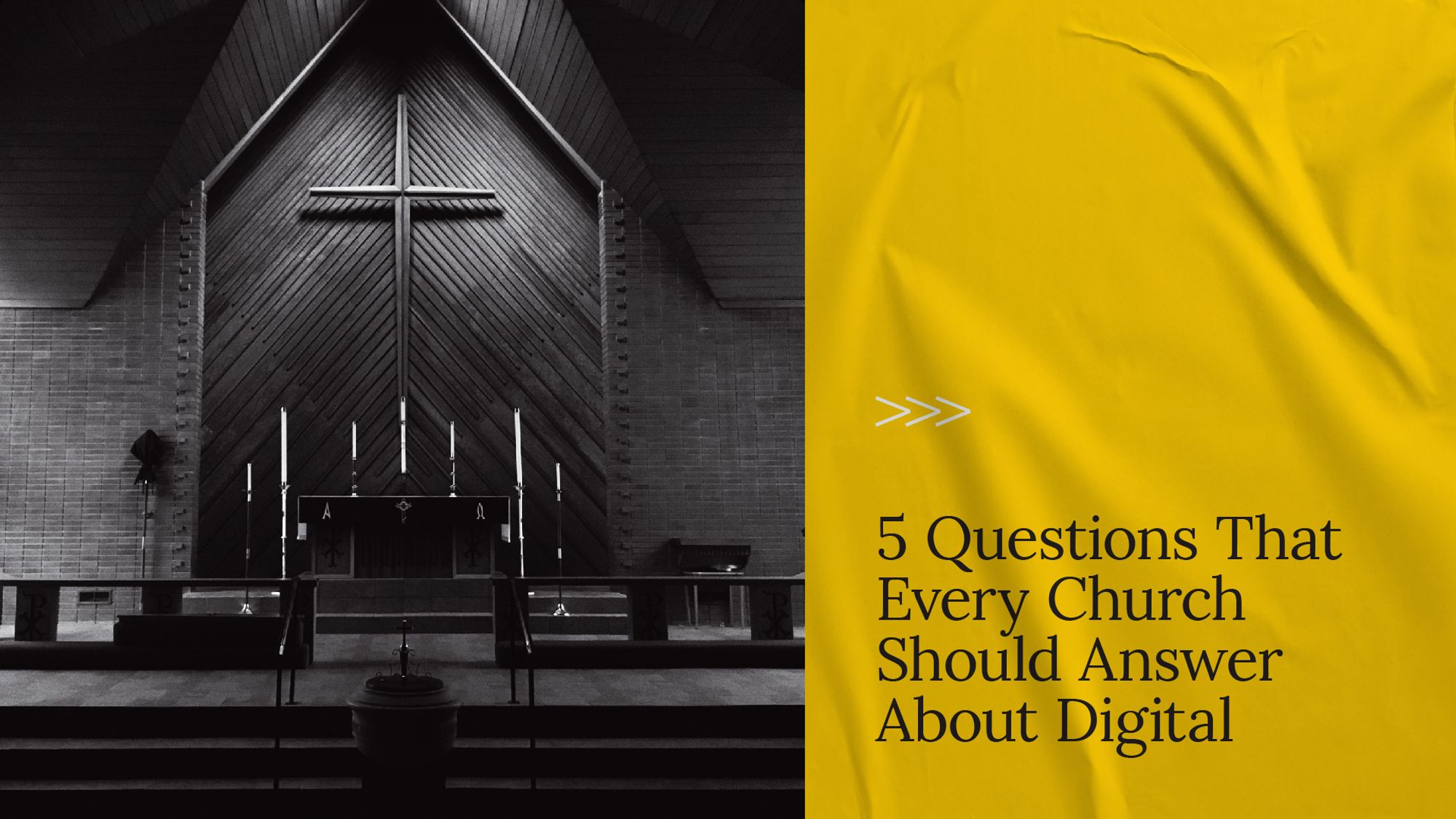
Darin Yates has been the Executive Pastor at Crossroads Church in Cincinnati, OH for the past 20 years. Crossroads has consistently been one of the largest and fastest-growing churches in America and is seen as an innovator in digital ministry. Crossroads has a thriving online community and one of the most effective digital strategies and online tools in the church world. Darin details some of the things they have learned over this time period.
Question #1: Are you crystal clear on what a digital ministry looks like for your church?
Crossroads had an “I’m in” financial campaign for multi-site campuses and some other initiatives that raised over $100 million. As we extrapolated how many more buildings we would need if God kept us on the same growth trajectory, we estimated that we would soon be needing an almost $ 1 billion dollar capital campaign. Who wants to sign up for that?
We had to find new and more efficient ways to reach new people for Jesus and bring them into strong relationships within the church. Our initial efforts were designed to try to replace everything we could do in buildings with digital offerings. We soon realized that we were heading down the right path. Digital products should extend and enhance your ministry not replicate your ministry. We really needed to slow down, understand what God was doing with us as a church, and determine the right way to leverage each digital and physical asset to disciple our community. Different assets have different strengths and weaknesses. Use buildings in ways that can only be done in person and use digital tools in ways that can best be done digitally. Simple, huh? However, it certainly wasn’t clear or simple at the time.
Most church leadership teams realize that digital platforms are necessary in today’s church in order to communicate well and grow their church. Almost all of the time, some of the leadership team are “absolutely positive” that they know what is needed (Spoiler alert: they are usually wrong.). Some others are not so sure. And others have no idea. That is, until you’ve invested time and money into something. At that point, everyone can tell you exactly what is wrong with it. That iterative process is important and you can learn a lot through it. However, you want to start the process aiming in the right direction or changes become formidable. You would not build a building before you know how you’re going to use it. Why would you build a digital infrastructure before you’ve designed it? If you are not fully committed to how you are going to pursue digital engagement with your church, you will fracture trust with your team and potentially waste a whole bunch of money developing products that aren’t effective or necessary.
The Clear Path Forward can help you and your leadership team aim in the
right direction as you design a strategy for creating an effective and
engaging digital experience.
Question Number 2: Who can I lean on when things get complex?
Being an Executive Pastor at a large, growing church is hard and oftentimes lonely. Senior Pastors tend to have larger support networks of people who have walked the path ahead of them. Executive Pastors and Digital/Online Pastors tend to learn as they go. I remember going to a conference about 17-18 years ago where I met a guy named Kevin Penry who was Executive Pastor at Life.Church at the time. It was comforting to know that I could shoot an email or pick up the phone and find wisdom from Kevin when I needed it. He was always very gracious but I wanted to make sure I didn’t take up too much of his valuable time. In the past few years, I’ve been able to build a network of peers that I can rely on when I need some counsel. Everyone needs that group of people you can learn from and with. My network of peers and friends has been exceedingly helpful through the years. There are many times when I do not have the answer but I know who I can connect with to get help developing the answer.
Discover community and support among like-minded leaders in our Virtual Round Tables
Question Number 3: What are the purposes of each of your
digital tools?
The standard digital platforms in the Church are self-serving and boring. Apps become “digital bulletins” and websites are full of “information about the church.” As church leaders, we have to move beyond digital tools whose primary function is to share information about the church. We need to get to know the individuals that are utilizing our tools and then load their devices with content and community that guides them into a deeper relationship with Jesus and the church. Having mobile devices allows the church to vastly expand the quantity and quality of time they get to spend with their congregations.
However, we as churches love to invite people to things. It is in our DNA. We like to fill up announcements inviting our people to 400 potluck dinners per year. Those 3-5 minutes in the middle of a service are valuable Spiritual real estate. Then we use our website and apps to scream the same invitations often to the same group of people. Too many churches build their digital portfolio without enough foresight into what each tool should be doing for them. Then they overload each product in the portfolio with the same content.
Question Number 4: What are the right measures and ratios for a culturally current church?
We, as the Church, have to move away from a “how many?” culture to a “who?” culture. We need new standards of how we recognize who is engaging with the church. Our historical bellwether measures and ratios don’t seem to be as helpful as they used to be.
In a world of physical and digital attenders, counting butts in seats isn’t as meaningful. Ratios of attenders to staff used to be the primary tool that churches used to maintain the right level of organizational structure. COVID and the changes it has accelerated in the American church make most of these measures irrelevant. Beyond that, it isn’t about us as the church, it is about the individual that God wants to reach through your church.
At Crossroads, our analytics and research team did a study to find out which things ultimately led to spiritual growth in people. They determined, with statistical significance, that there are seven proven practices that lead to growth. They are:
- receiving weekly teaching
- daily time with God
- serving others
- community
- baptism or a public declaration of your faith
- sharing your story
- giving
Our research showed that any one of these alone lead to growth in your relationship with God. It might surprise you that the one that makes the most significant change in our Spiritual growth was daily time with God, even though most churches like to push attendance, serving, groups, and giving. These are self-serving for the church. Our team also found that if you do any four of these, your Spiritual maturity level significantly increases. Again, I’ll repeat because it is important, we have to go beyond a “how many?” culture to a “who?” culture.
Question Number 5: What is the right organizational structure to unleash a digital ministry while simultaneously growing physical attendance?
This is a difficult one to tackle in a short paragraph. We’ve shuffled through many different versions at Crossroads. At one point, we tried to treat online church as if it was “just another site.” That was, at best, wrong. At worst, very damaging. We tried layering on digital engagement to everyone’s job responsibilities within our matrix organization at the time. That led to digital being ignored for the most part. We tried splitting off digital engagement as a completely separate ministry. That was ultimately going to lead to two different church models.
The model that is working well for us is dividing Experiences and People Ministries into two different organizations, both having physical and digital responsibilities. We also shifted to a “Double Helix” organization where there are overlaps in responsibilities between teams, both having equal authority. This has led to our teams getting crystal clear on which team has responsibility for work and projects. It has also led to some very healthy conflict that has sharpened us as a team. Again, this works for us but there is not a one-size-fits-all approach. It is important to find time to resolve some organizational friction that leads to ministry ineffectiveness.
Most church leaders start with how they are going to organize for success in digital and try to determine the right roles. While the right organizational structure and roles are important, the right leader is the absolute most important determining factor for success. If you want to expand your church’s engagement through digital platforms and tools, assign your most creative and talented leader to the task and ask them what they need to make it happen.
We'd love to invite you and your team to take the first step toward clarifying your digital strategy. During a Clear Path Forward, we'll assess your current reality, understand your ministry needs, and develop a strategy to implement with your team.
- Buildings and Finance Insights (74)
- Ministry Insights (71)
- Organizational Insights (62)
- Church Growth (59)
- Leadership (48)
- Buildings and Finance (37)
- Facility Strategy (33)
- Financial Strategy (29)
- Digital Engagement (28)
- Organizational Clarity and Strategy (28)
- Featured Insight - Buildings and Finance (23)
- Multisite (21)
- Digital Engagement Insights (19)
- Buildings That Fund Ministry (17)
- Media (17)
- Featured Insight - Buildings That Fund Ministry (15)
- Church Debt (12)
- Ministry Growth (12)
- Hiring (6)
- Strategy (5)
- Insight FEATURED (4)
- Ministry Strategy (4)
- Church Mergers (3)
- Digital Strategy (3)
- Featured Insight - Multisite (3)
- Merger Insights (3)
- Clarity (2)
- Consultants (2)
- Data Analysis and Reporting (2)
- Featured Insight - Digital Engagement (2)
- Ministry Solutions Group (2)
- Organizational Leadership (2)
- Clear Path Forward (1)
- Consultants - Ministry Strategy (1)
- Featured Insight - Project Financing (1)
- Featured Insight - Succession Planning (1)
- Ministry Solutions Group Team (1)
- Succession Insights (1)

 Darin Yates
Darin Yates



Thoughts or insights? We'd love to read them. Please share your insights below.